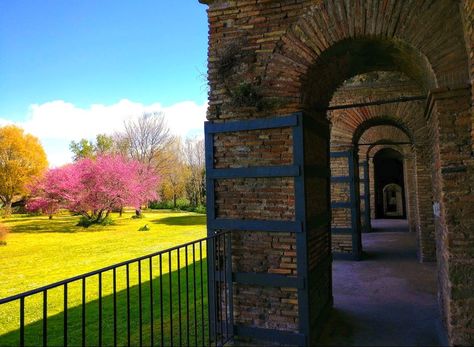| Erecting walls might seem an original idea, but the Ancient Romans had already built them all around the Mediterranean area to keep their cities safe from the incursions of enemies. Although they were quite unable to keep 'the others out, they were built with skillfulness and art, so they are now a beautiful and charming attraction of Rome. The Aurelian Walls are the longest and best preserved Ancient Walls of Europe, and out of the original 19 kilometers (12 miles), 12 kilometers are still intact (8 miles). |
They were built by Emperor Aurelian and later reinforced by the Eastern Emperor Honorius to keep the Goths out. Honorius doubled the height of the walls to 11 feet thick and 24 high. Every thirty meters, there was a watch tower with a ballista, 381 in total, with 18 main gates flanked by smaller and 114 latrines.
| The Museum of the walls, surprisingly free of charge, is located inside the imposing Porta San Sebastiano, once called Porta Appia, facing the Appian Way, the most important consular road built by Appian Claudius the Blind in the fourth century BC. Later the gate took the name of a soldier who suffered martyrdom, St. Sebastian. The Museum opened in 1990, even if already in 1940-43 underwent some significant restorations to become the alcove of the fascist secretary Ettore Muti. |
The black and white mosaic on the first floor connecting the two towers dates back to his time. The view from the windows of the first level is already worth the climbing: on one side, the Arch of Drusus, part of an Ancient Aqueduct (Aqua Antoniniana) that once fed the Caracalla's Baths, and the villas on the Appian Way on the other side.
| Despite their solid appearance, they could not protect the city. Most of the time, the Barbarians entered through the opened gates, showing the military inefficiency of the decaying Roman Empire. In 1327 the gate became a scene of struggles between the two parties supporting the Pope (Guelphs) and the king of Naples (Ghibellines). When the Papal party won, the Archangel Michael defeated a dragoon engraved in the inner part of the central gate. From the first level, a slight draft door will take you to the fascinating part of the walls: the ancient covered walkway with arches lined in unique geometric perfection. |
In one of the watchtowers, you will find a fresco of a Madonna, apparently a memory of a romitorio, the simple refuge of a hermit. The walls suffered collapses and damage for the erosion of elements, and some of the steps were restored with ancient recycled marbles. From the top of the walls, you can taste a fantastic view over the roman countryside part of the Regional Park of the Appian Way.
Tips: The bike is the best way to taste this part of Rome, especially on Sunday when the Appian Way is pedestrian. Always bring a U-lock to tide the bikes to a tree or a road sign while visiting sights along the way.
Bus number 118 is the bus which will take you here from the Colosseum.
The Museum of the Walls is open every day except Monday from 9 to 14. It is free of charge.
You can also visit the Catacombs on the Appian Way, the Caracalla's Baths, Villa of the Quintilii.
If you need any further information, contact me at info@mylovelyrome
Tips: The bike is the best way to taste this part of Rome, especially on Sunday when the Appian Way is pedestrian. Always bring a U-lock to tide the bikes to a tree or a road sign while visiting sights along the way.
Bus number 118 is the bus which will take you here from the Colosseum.
The Museum of the Walls is open every day except Monday from 9 to 14. It is free of charge.
You can also visit the Catacombs on the Appian Way, the Caracalla's Baths, Villa of the Quintilii.
If you need any further information, contact me at info@mylovelyrome



